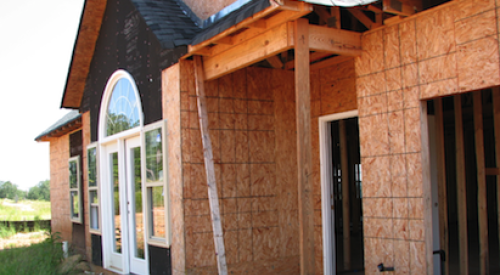|
| In this ad, the Olson Co. cleverly positioned its “discount” by bundling federal and state first-time buyer tax credits with an offer to match the buyer’s 2008 tax refund. |
In January 2009, D.R. Horton launched a marketing campaign in Las Vegas called the Builder Short Sale. Prospective home buyers were urged to compare the advantages of purchasing a new Horton home to buying a foreclosed home. A spokesperson for D.R. Horton told the Las Vegas Review-Journal that the builder was offering discounts of up to $70,000. The newspaper subsequently reported that Horton sold 150 homes in two days.
D.R. Horton would not respond to Professional Builder's phone calls about the Short Sale, though it was clearly a success, prompting the company to repeat the event in April. Discounting is pervasive across all regions of the United States, as builders struggle to get rid of inventory in markets where housing values have plummeted and foreclosures are skyrocketing.
| “Discounting is necessary in some markets where there are huge inventories. But there are other concessions builders will make, especially in large developments. In [Southern California’s] Inland Empire, some builders are building smaller units so they can price them closer to market rate.” — Delores Conway, director, Casden Real Estate Economics Forecast, USC Lusk Center for Real Estate, Los Angeles |
“Usually price cuts become necessary at a level when incentives aren't enough to motivate people to buy, or where the local market has become destabilized by other changes in comparables, pricing or a lot of resale inventory — particularly a distressed resale inventory,” says Peter Dennehy, senior vice president of Sullivan Group Real Estate Advisors in San Diego. “Those factors are all very much present.”
Dennehy continues: “The bottom line is that value is what's driving sales right now, and a lot of that value is foreclosures and REOs. I think new-home builders can compete well against that, but ultimately, the price has to be perceived by the home buyer as competitive in whatever market they're in.”
Then there's the question of whether discounting negatively affects a builder's reputation or the buyer's perception. Sharon McCabe, associate director of the Graaskamp Center for Real Estate at the University of Wisconsin in Madison, Wis., doesn't think this is an issue.
“Buyers today are hesitant for several reasons, job security being paramount,” says McCabe. This is where builders can put a positive spin on a marketing campaign that revolves around price reductions. “They can empathize with the buyer and offer incentives to calm those fears,” she says, referring to mortgage protection plans that pay the homeowner's mortgage for a specified period of time in the event of a job loss.
It's important to note that builders are making other concessions besides discounts, particularly in large developments where a portion of the homes are already sold. “Maybe they would prefer not to discount because of the people who bought at higher prices,” says Delores Conway, director of the Casden Real Estate Economics Forecast at the USC Lusk Center for Real Estate in Los Angeles. “A lot of times they'll go with upgrades, such as granite countertops or higher-end appliances. This is especially true of condo developments where there's a lot of uniformity in the units.”
| “Lowering prices due to market compression obviously is counterproductive to margin contribution. We do, however, have a fiduciary responsibility to our investment partners to build and sell homes in a timely manner. We are fortunate as an organization that we do not have a large number of standing inventory units or undeveloped land parcels that would pressure us into a ‘fire-sale’ mode.” — Scott Laurie, president and chief operating officer, Olson Co., Seal Beach, Calif. |
In order to finish developments that are already entitled, builders are also cutting square footage, especially in California's overbuilt Inland Empire. Smaller homes not only cost less to build but can be priced closer to market rate. “Some of the houses have the same façade as the rest of the development, but they're 2,000 square feet instead of 3,000 square feet,” Conway says.
The Olson Co. of Seal Beach, Calif., specializes in walkable, in-town communities located close to employment centers, public transportation and retail areas. That in itself is a competitive advantage, says Bill Holford, senior vice president of marketing and sales for Olson. By anticipating market demand and eliminating land holdings in excess of $7,000 or $8,000 per home price point, it has been able to avoid discounting altogether.
“Most of our product is attached — buildings with anywhere from five to nine homes,” Holford says. “And we're very systematic not only in terms of our buildings, but also how we're selling and phasing. We have virtually no standing inventory.”
Rather than try to compete with foreclosures on a price basis, Olson is following the D.R. Horton example: emphasizing the wisdom of buying a new home with a 10-year warranty.
| “Here’s my analogy: like new-home builders, luxury car manufacturers such as BMW, Mercedes and Lexus are currently offering their products at reduced prices. Do these price discounts affect BMW or Mercedes’ reputation or buyer perceptions? I think not.” — James Shilling, Michael J. Horne Chair in Real Estate Studies, DePaul University, Chicago |
That said, there's a right way and a wrong way to discount. According to new-home sales experts Bob Schultz and Myers Barnes, it all comes down to positioning: how the offer is advertised and how the salespeople present it.
“The buyer does expect a discount, and whether you like it or not, you're in the negotiation game,” says Barnes, founder of Myers Barnes Associates in Kitty Hawk, N.C. “It's an educational challenge on how to minimize the impact of the amount you're going to give away.”
Schultz, founder and president of New Home Sales Specialists in Boca Raton, Fla., says far too many builders have been discounting. “Discounts are bad; incentives are good,” he says. “For the savvy buyer, your discounted price just became their new point of beginning. In other words, if you, the builder, tell me, the buyer, that you've discounted your price from $1 million to $750,000, great. That's where we're going to start now because I want it for $500,000.”
Builders who merely give discounts are sending out a distress signal, Schultz says. Although price adjustments are necessary in many cases, a builder needs to look closely at key economic indicators — particularly the foreclosure and resale markets — before deciding where prices should be. “Once you make that decision and can justify it economically, you position it with incentives,” he says.
| “Most builders are looking at foreclosures, resales and new homes and coming up with what I call the brass tacks or ‘reality pricing.’ [They] can’t get a huge premium anymore for new construction because the almost-new resale is plentiful.” — Debra Bernard, The Bernard Partnership, Walnut Creek, Calif. |
For example, instead of dropping the price of a home $50,000, the builder leaves the price as-is and tells customers that for a limited time only, they're eligible for an incentive, such as $10,000 worth of upgrades. “You could also offer the incentive for the next two, three, five or 20 sales,” says Schultz. “We suggest using the number of homes that you expect to sell in two weeks.” Builders with multiple communities in a market can offer different incentives at each community. The key words in the salesperson's arsenal are “limited-time incentive opportunity.”
“I contend that discounts alone do not generally turn non-buyers into buyers, unless your discounts are so huge that you're getting the bargain-basement seekers out,” Schultz says. “But a properly positioned incentive takes somebody who's probably thinking about buying anyway and causes them to do it sooner rather than later.”
Debra Bernard, president of The Bernard Partnership, a consulting firm with offices in Walnut Creek, Calif., and Simsbury, Conn., says the first-time buyer tax credit seems to be having a positive effect on traffic and sales. Some California cities are reducing impact fees to stimulate residential construction. But builders still need to do their homework and be flexible about pricing.
“If a customer's coming in and saying, 'I can buy a foreclosure down the street for $85 a foot and you're charging me $110 a foot,' then it's too late,” says Bernard. “You really need to know what foreclosures are selling for and maybe add $5 or $6 a foot for new construction.”
What about the people who paid a lot more for their homes before the crash? Bernard thinks those homeowners understand why builders need to cut prices. “They see what's going on with the stock market and the economy in general,” she says. “They're happy if the builder's still honoring warranties and maintaining the neighborhood.”
Schultz urges builders to be proactive. “Rational people understand if it's explained to them. You didn't create the new marketplace.”
|












